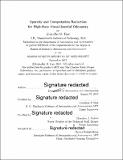Sparsity and computation reduction for high-rate visual-inertial odometry
Author(s)
Frey, Kristoffer M. (Kristoffer Martin)
DownloadFull printable version (16.77Mb)
Other Contributors
Massachusetts Institute of Technology. Department of Aeronautics and Astronautics.
Advisor
Jonathan P. How and Theodore J. Steiner.
Terms of use
Metadata
Show full item recordAbstract
The navigation problem for mobile robots operating in unknown environments can be posed as a subset of Simultaneous Localization and Mapping (SLAM). For computationally-constrained systems, maintaining and promoting system sparsity is key to achieving the high-rate solutions required for agile trajectory tracking. This thesis focuses on the computation involved in the elimination step of optimization, showing it to be a function of the corresponding graph structure. This observation directly motivates the search for measurement selection techniques to promote sparse structure and reduce computation. While many sophisticated selection techniques exist in the literature, relatively little attention has been paid to the simple yet ubiquitous heuristic of decimation. This thesis shows that decimation produces graphs with an inherently sparse, partitioned super-structure. Furthermore, it is shown analytically for single-landmark graphs that the even spacing of observations characteristic of decimation is near optimal in a weighted number of spanning trees sense. Recent results in the SLAM community suggest that maximizing this connectivity metric corresponds to good information-theoretic performance. Simulation results confirm that decimation-style strategies perform as well or better than sophisticated policies which require significant computation to execute. Given that decimation consumes negligible computation to evaluate, its performance demonstrated here makes decimation a formidable measurement selection strategy for high-rate, realtime SLAM solutions. Finally, the SAMWISE visual-inertial estimator is described, and thorough experimental results demonstrate its robustness in a variety of scenarios, particularly to the challenges prescribed by the DARPA Fast Lightweight Autonomy program.
Description
Thesis: S.M., Massachusetts Institute of Technology, Department of Aeronautics and Astronautics, 2017. Cataloged from PDF version of thesis. Includes bibliographical references (pages 147-151).
Date issued
2017Department
Massachusetts Institute of Technology. Department of Aeronautics and AstronauticsPublisher
Massachusetts Institute of Technology
Keywords
Aeronautics and Astronautics.